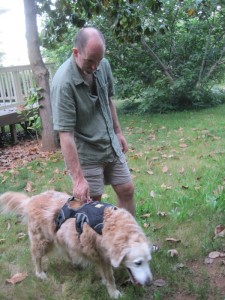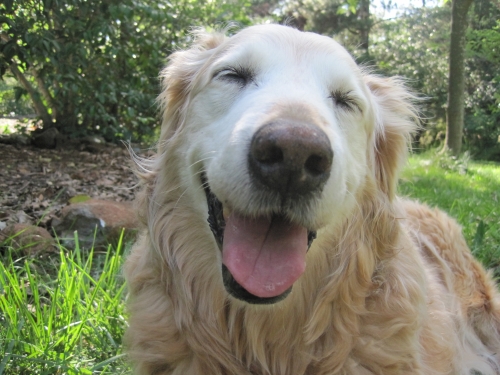There was something terribly wrong with my almost-13-year-old golden retriever, Holly. It happened suddenly, out of the blue:
Her symptoms were:
- Nausea/vomiting
- Nystagmus (eyes flickering back and forth) and rhythmic eyebrow twitching
- Severe head tilt: One ear was pointing to the floor, the other ear was pointing to the ceiling
- Apparent confusion/disorientation: She was looking around the room in an unfocused fashion, as if she didn’t know where she was or what was happening
- Inability to walk or stand: She scrabbled around helplessly on the floor. When we lifted her, she lurched sideways, staggered, and fell against the wall. She had a no balance. Some dogs walk in circles.
It was very alarming.
Was this a stroke? An ominous neurological affliction?
No, these are classic signs of Canine Vestibular Disease, also down as Old Dog Vestibular Disease. It is a problem with the inner ear, causing dizziness, loss of balance, and nausea.
Basically, the dog feels seasick.
Its hallmark symptoms are a sudden acute onset (as in: your older dog is perfectly fine, and half an hour later her condition appears utterly dire; cue panic on your part) and then, after a few difficult days, a fairly rapid improvement. Severe symptoms are generally gone within several weeks. While it looks (and is) distressing, most dogs recover completely. Some might have a permanent head tilt or slightly wobbly gait.
When my husband urgently called our vet to schedule an appointment for Holly, the receptionist interrupted him as he was describing the awful symptoms. “She has Canine Vestibular Disease,” she said confidently. “You don’t have to bring her in, she’ll be fine.”
She didn’t look fine! We brought her in.
The vet diagnosed Canine Vestibular Disease, and said she’d be fine.
Here’s what nystagmus, a distinguishing feature, looks like:
Dogs need supportive care – assistance with eating, drinking, and walking – until they are functional again.
Holly was unable to walk or even stand, and refused any attempt to move. For two days we had to carry her outside and encourage her to pee, a time-consuming process as she stood unsteadily in the yard, gazing around at her spinning world, swaying on her feet while we kept her upright.
Things that worked for us during that first week were:
- Giving her food and water in a shallow bowl, like a pie plate or shallow Tupperware container. She seemed to have trouble with her (deeper) dog dish.
- Have a rag or towel handy. Holly had a severe head tilt to the left; she ate and drank from the extreme left-side of any bowl, regardless of its placement. Generally, that meant a lot of food and water got slopped onto the floor to her left.
- Sometimes I just hand-fed the dog food to her. It works, if you’re not squeamish. I’m a nurse, so I have my hands in all kinds of nastiness. Dog food? Not a problem.
 We have a dog backpacking harness with a handle which was extremely helpful. We put her harness on every time we went outside, using it to lift and steady her as she lurched around. If you don’t have one, a harness might be fashioned from a T-shirt or pillow case by slipping the item around the dog and using it to support her. This video, http://www.youtube.com/watch?v=GGFECxUWkd4, shows a vet making a supportive dog sling from a cloth grocery bag. An unsteady, dizzy dog may need a wider sling, covering more of its abdomen for more robust support.
We have a dog backpacking harness with a handle which was extremely helpful. We put her harness on every time we went outside, using it to lift and steady her as she lurched around. If you don’t have one, a harness might be fashioned from a T-shirt or pillow case by slipping the item around the dog and using it to support her. This video, http://www.youtube.com/watch?v=GGFECxUWkd4, shows a vet making a supportive dog sling from a cloth grocery bag. An unsteady, dizzy dog may need a wider sling, covering more of its abdomen for more robust support.- Our vet suggested over-the-counter meclizine (also called Dramamine II or Bonine), which improved her dizziness and nausea (and, subsequently, her appetite). She readily ate the pill concealed in a glob of peanut butter. Consult your vet for dosages and frequency.
- Some vets prescribe other anti-nausea medications or (if the problem is caused by an ear infection) antibiotics. In severe cases, the dog may need to be hospitalized for IV fluids to prevent dehydration.
Three weeks later, here’s how she looked:
Does your dog have Canine Vestibular Disease?
Hang in there! Chances are, you’ll both be feeling better soon.

Helpful links and websites:
- An informative video from a veterinarian discussing Canine Vestibular Disease: http://www.youtube.com/watch?v=AYD5hg_n5GI
- A video showing a dog, Casey, with classic Canine Vestibular Disease: http://www.youtube.com/watch?v=zcX0-UWig1s
- A thorough (and reassuring) article from a veterinarian about Canine Vestibular Disease: http://www.petmd.com/blogs/fullyvetted/2011/oct/old_dog_vestibular_disease-11847
- Another article packed with great information: http://vestibular.org/sites/default/files/page_files/Vestibular%20disease%20in%20dogs%20and%20cats.pdf
- http://www.vcahospitals.com/main/pet-health-information/article/animal-health/vestibular-disease-in-dogs/856
- http://veterinarysurgicalcenters.com/Vestibular_disease.html

Pingback: Poncho Likes the Good Stuff - Carol Beebee
We are experiencing this condition right now although I think we are into the improvement stage. Thank-you for confirming the vets diagnosis. Your description of the symptoms is spot-on. We are confident that we will get through this thing. Thank-you for sharing your story.
Best of luck to you and your dog!! *heart*
Thank you for taking time out to write this article Carol. It is extremely helpful to all families with dogs. The information you have given is extremely helpful. Thanks again!
Thanks, I appreciate that! 🙂
This is the second time in 2 weeks we are going through this with my 14 year old Golden. Had her to the Vet & they did blood work & X-rays and $400 later I’m told “she’s just old & her Liver is abnormally shaped????
Yikes! I hope she’s better… And I hope you have a good vet.
Thank you for writing this! This post saved us a trip to the emergency vet at midnight. Our dog started experiencing these exact symptoms and the vet confirmed the diagnosis the following day. The video of the eye twitching was really helpful.
I’m so glad it was helpful, thank you! Hope your dog bounces back fast!!
Lily, our Golden retriever/black Lab cross started this today, initially lasting for 10-15 mins. This evening, after returning from a gentle walk on a lead it started again and she brought up her evening meal in the garden and then proceeded to eat it again! She isn’t holding her head to one side and is now laying calmly in her bed. Lily will be 13 this September. Thank you so much for writing this article, it was very reassuring to read and confirmed her condition. Time will now tell. Lily is the 13th dog that we’ve adopted so are fairly familiar with age related problems but making that final decision and journey never gets any easier.
It sounds like she’s in good hands! Hopefully it will pass quickly and she can get back to her normal happy life. *heart*
My Staffie has just done the exact same out of the blue .. it’s so horrible to watch .. is the vet a waste of time ?
Ugh, I know how distressing it is! I’m not sure I can counsel you on whether or not to go to the vet — you might want to call the office, describe the symptoms, and see what they say. My vet said I didn’t need to bring her in, but I was anxious so I did. Kinda a waste of time since they couldn’t “do” anything, except it gave me peace of mind, which is something!
This was extremely helpful!! Thank you! Our 13 year old dog just experienced this and we thought it had gotten into chocolate but it was this! So scary.
I’m so glad this was helpful! It’s really scary-looking, but usually doesn’t last long. Glad your dog didn’t get into chocolate! Happy New Year!